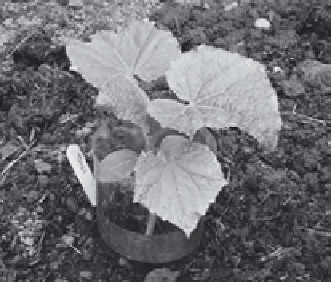Agriculture Reference
In-Depth Information
otherwise get dug up by mice before
they've even had a chance to germi-
nate, and can be left in place for the
entire life of the plant.
Copper tarnishes over time, and then
slugs can cross it. It can be brightened
up again by rubbing it with glass paper
or something similar - a green dish
scrubber works very well. If the tarnish
is very heavy, a few drops of vinegar
will help. However, once it has been
polished (and especially if you used
vinegar), the surface will tarnish faster than before. Make sure you rinse the
vinegar away immediately after cleaning, and be prepared to shine it up again a
few weeks later.
Bottle cloche
Thrips
Thrips are tiny insects that affect a wide variety of plants by sucking out cell
contents, causing scarred and distorted growth and fruit. Insecticidal soap and
plant oil-based sprays are common organic remedies, as are commercially avail-
able predatory mites.
Vine weevil
Usually only a real problem in pot-grown plants, adult vine weevils feed on the
edges of leaves. However, the real problem is the larvae, which feed on roots and
can kill the plant. Lift suspect plants from their pots as soon as possible after
purchase and have a good look around to see if either larva or adults are present.
If they are, replant in fresh compost after knocking all the existing earth from the
root ball.
Adult vine weevils are mainly active at night and are surprisingly nimble, drop-
ping to the ground if startled by movement or bright light, so trapping them is
much easier than trying to catch them. Use sticky barriers such as tree grease
around the base of plant pots and staging, and leave rolls of corrugated card-
board around for them to shelter in. Moist sacking can be left on the paths in the
evening and checked for sheltering adults in the morning, along with the under-
side of plant pots (another favourite hiding place). If things get out of hand,
commercial biocontrols are available.
White rot
White rot is the most serious disease affecting alliums (mainly onions) in the UK
because it persists in the soil for so long - up to 18 years. Look out for plants that
appear yellow and stunted. When lifted, they show signs of a white or grey

































